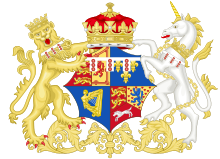Caroline of Great Britain, Ireland and Hanover

Princess Caroline Elisabeth of Great Britain, Ireland and Hanover (born June 10, 1713 in Herrenhausen , Hanover ; † December 28, 1757 in St. James's Palace , London ) was the fourth child and third daughter of King George II of Great Britain and his Mrs. Caroline von Ansbach .
family
Princess Caroline was born on June 10, 1713 in Herrenhausen Palace in Hanover. Her father was Hereditary Prince Georg August of Hanover, the eldest son of Elector Georg Ludwig of Hanover . Her mother was Caroline von Ansbach, the daughter of Margrave Johann Friedrich von Brandenburg-Ansbach . As the daughter of the Elector of Hanover, Caroline was referred to as Princess Caroline of Hanover from birth. The day after she was born, she was baptized in Herrenhausen Palace. Due to the Act of Settlement of 1701, Caroline was seventh in line to the British throne at the time of her birth.
Life
After Queen Anna's death in 1714, Caroline's grandfather ascended to the British throne as George I, and her father became Prince of Wales. Caroline thus received the title of Princess of Great Britain . At the age of one, Caroline moved to Great Britain with her mother and older sisters Anna and Amelia , where the family lived in St James's Palace. In 1722 she and her sister Amelia were treated by the doctor Dr. Maitland vaccinated against smallpox.
Princess Caroline was considered a favorite daughter of her mother and was known to always tell the truth, which is why they also Truth lover was called ( "truth-loving").
According to popular opinion, Caroline was melancholy because she was unhappily in love with the married courtier John Hervey, 2nd Baron Hervey. After his death in 1743, Caroline withdrew to St James's Palace and was only accessible to family and close friends.
Caroline made generous donations to charities.
Princess Caroline died unmarried and childless on December 28, 1757 at St James's Palace in London. She was buried in Westminster Abbey .
Horace Walpole wrote about her death: "Though her state of health had been so dangerous for years, and her absolute confinement for many of them, her disorder was, in a manner, new and sudden, and her death unexpected by herself, though earnestly her wish. Her goodness was constant and uniform, her generosity immense, her charities most extensive; in short, I, no royalist, could be lavish in her praise. "
“Though their health had been so poor for years, and their isolation for many of them as well, in some ways their illness was new and sudden, and their death unexpected of themselves, if indeed their desire. Their kindness was unwavering and constant, their generosity immense, their charity greatest; in short, I, not a royalist, could be lavish in their praises. "
Individual evidence
- ^ Edmund Lodge: The Genealogy of the Existing British Peerage: With Sketches of the Family Histories of the Nobility. Retrieved October 18, 2019 .
- ↑ John van der Kiste: George II and Queen Caroline . Sutton Publishing, Stroud, Gloucestershire 1997, pp. 83 .
- ↑ John van der Kiste: George II and Queen Caroline . Sutton Publishing, Stroud, Gloucestershire 1997, pp. 163 .
- ^ A b John van der Kiste: George II and Queen Caroline . Sutton Publishing, Stroud, Gloucestershire, S. 197 .
- ^ N Gland: The royal princesses of England, from the reign of George the First . George Routledge and Son, 1871, p. 123 .
| personal data | |
|---|---|
| SURNAME | Caroline of Great Britain, Ireland and Hanover |
| ALTERNATIVE NAMES | Caroline Elisabeth from Great Britain, Ireland and Hanover |
| BRIEF DESCRIPTION | british princess |
| DATE OF BIRTH | June 10, 1713 |
| PLACE OF BIRTH | Herrenhausen , Hanover |
| DATE OF DEATH | December 28, 1757 |
| Place of death | St. James's Palace , London |
